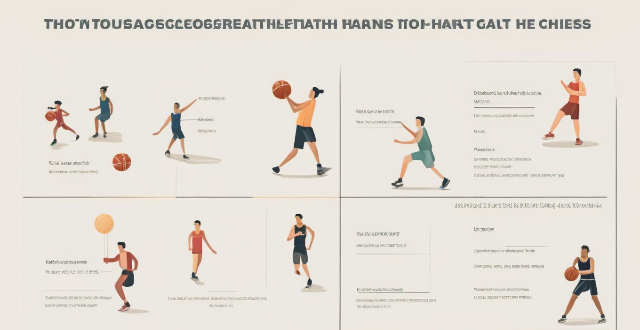The article discusses how to design a basketball training program to increase vertical leap, which is an important skill in the sport. It highlights the importance of understanding factors that affect vertical leap such as muscle strength, body composition, flexibility, and neuromuscular coordination. The article provides examples of exercises that can be used to target these factors, including squats, lunges, plyometric exercises, calf raises, and hip-flexor stretches. It also outlines a four-week training plan with progressive overload to gradually increase the intensity of the exercises. The plan includes rest days for recovery and proper warm-up and cool-down techniques to prevent injuries and promote recovery.

How to Design a Basketball Training Program for Increasing Vertical Leap
Introduction
Basketball is a sport that requires a combination of skills, including shooting, dribbling, passing, and jumping. One of the most important skills in basketball is the ability to jump high, which can give players an advantage on the court. In this article, we will discuss how to design a training program to increase your vertical leap.
Key Points
* Understand the importance of vertical leap in basketball
* Identify the factors that affect vertical leap
* Choose appropriate exercises for improving vertical leap
* Create a training plan with progressive overload
* Incorporate recovery techniques into the training program
Understanding the Importance of Vertical Leap
In basketball, having a strong vertical leap can help you score more points by making it easier to shoot over defenders or reach higher baskets. It also allows you to block shots from opponents and grab rebounds more effectively. Therefore, improving your vertical leap can significantly enhance your performance on the court.
Factors Affecting Vertical Leap
Several factors can impact your vertical leap, including:
* Muscle strength: The strength of your leg muscles, particularly your quadriceps and glutes, plays a crucial role in determining how high you can jump.
* Body composition: Having a leaner body composition with less fat and more muscle mass can improve your vertical leap.
* Flexibility: Being flexible in your hips and ankles can help you generate more power when jumping.
* Neuromuscular coordination: Your ability to coordinate the activation of multiple muscle groups during a jump can also affect your vertical leap.
Choosing Appropriate Exercises
To improve your vertical leap, you should focus on exercises that target the key factors mentioned above. Some effective exercises include:
* Squats: This exercise strengthens your leg muscles, particularly your quadriceps and glutes.
* Lunges: Lunges work your legs in a similar way to squats but also improve your balance and stability.
* Plyometric exercises: These explosive movements, such as box jumps and depth jumps, train your muscles to produce maximum force in a short amount of time, which is essential for improving your vertical leap.
* Calf raises: This exercise targets your calf muscles, which are responsible for pushing off the ground during a jump.
* Hip-flexor stretches: Stretching your hip flexors can improve your flexibility and range of motion, allowing you to generate more power when jumping.
Creating a Training Plan with Progressive Overload
To maximize the effectiveness of your training program, it's important to create a plan that gradually increases the difficulty of your exercises over time. This concept is known as progressive overload and can help you avoid plateauing in your progress. Here's an example of a four-week training plan:
Week 1: Foundation Building
* Squats: 3 sets of 10 reps at 60% of your one-rep max (1RM)
* Lunges: 3 sets of 8 reps per leg at 50% of your 1RM
* Box jumps: 3 sets of 6 reps at 75% of your maximum height
* Calf raises: 3 sets of 12 reps using bodyweight only
* Hip-flexor stretches: Hold each stretch for 30 seconds on each side, performing 2-3 repetitions per stretch
Week 2: Intensity Increase
* Squats: 3 sets of 8 reps at 70% of your 1RM
* Lunges: 3 sets of 6 reps per leg at 60% of your 1RM
* Box jumps: 3 sets of 8 reps at 80% of your maximum height
* Calf raises: 3 sets of 10 reps using additional resistance (e.g., dumbbells or a weighted vest)
* Hip-flexor stretches: Hold each stretch for 45 seconds on each side, performing 2-3 repetitions per stretch
Week 3: Power Development
* Squats: 3 sets of 6 reps at 80% of your 1RM
* Lunges: 3 sets of 4 reps per leg at 70% of your 1RM
* Box jumps: 3 sets of 10 reps at 90% of your maximum height
* Calf raises: 3 sets of 8 reps using additional resistance (e.g., dumbbells or a weighted vest)
* Hip-flexor stretches: Hold each stretch for 60 seconds on each side, performing 2-3 repetitions per stretch
Week 4: Peak Performance
* Squats: 3 sets of 4 reps at 90% of your 1RM
* Lunges: 3 sets of 3 reps per leg at 80% of your 1RM
* Box jumps: 3 sets of 12 reps at your maximum height
* Calf raises: 3 sets of 6 reps using additional resistance (e.g., dumbbells or a weighted vest)
* Hip-flexor stretches: Hold each stretch for 90 seconds on each side, performing 2-3 repetitions per stretch
Remember to rest for at least one day between training sessions to allow your muscles to recover and grow stronger. Additionally, make sure to warm up properly before each workout and cool down afterward to prevent injuries and promote recovery.